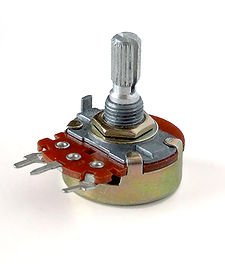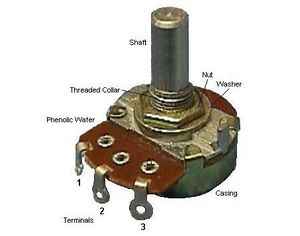Potentiometers
Potentiometer informally a pot, is a three-terminal resistor with a sliding contact that forms an adjustable voltage divider.If only two terminals are used, one end and the wiper, it acts as a variable resistor or rheostat.A potentiometer measuring instrument is essentially a voltage divider used for measuring electric potential , the component is an implementation of the same principle, hence its name.Potentiometers are commonly used to control electrical devices such as volume controls on audio equipment. Potentiometers operated by a mechanism can be used as position transducers, for example, in a Joysticks. Potentiometers are rarely used to directly control significant power , since the power dissipated in the potentiometer would be comparable to the power in the controlled load.
Potentiometer construction
Potentiometers comprise a resistive element, a sliding contact that moves along the element, making good electrical contact with one part of it, electrical terminals at each end of the element, a mechanism that moves the wiper from one end to the other, and a housing containing the element and wiper.
Many inexpensive potentiometers are constructed with a resistive element formed into an arc of a circle usually a little less than a full turn, and a wiper rotating around the arc and contacting it. The resistive element, with a terminal at each end, is flat or angled. The wiper is connected to a third terminal, usually between the other two. On panel potentiometers, the wiper is usually the center terminal of three. For single-turn potentiometers, this wiper typically travels just under one revolution around the contact. The only point of ingress for contamination is the narrow space between the shaft and the housing it rotates in.
Another type is the linear slider potentiometer, which has a wiper which slides along a linear element instead of rotating. Contamination can potentially enter anywhere along the slot the slider moves in, making effective sealing more difficult and compromising long-term reliability. An advantage of the slider potentiometer is that the slider position gives a visual indication of its setting. While the setting of a rotary potentiometer can be seen by the position of a marking on the knob, an array of sliders can give a visual impression of, for example, the effect of a multi-channel equaliser.
The resistive element of inexpensive potentiometers is often made of graphite. Other materials used include resistance wire, carbon particles in plastic, and a ceramic or metal mixture called cermet. Conductive track potentiometers use conductive polymer resistor pastes that contain hard-wearing resins and polymers, solvents, and lubricant, in addition to the carbon that provides the conductive properties. Others are enclosed within the equipment and are intended to be adjusted to calibrate equipment during manufacture or repair, and not otherwise touched. They are usually physically much smaller than user-accessible potentiometers, and may need to be operated by a screwdriver rather than having a knob. They are usually called preset potentiometers. Some presets are accessible by a small screwdriver poked through a hole in the case to allow servicing without dismantling.
Multiturn potentiometers are also operated by rotating a shaft, but by several turns rather than less than a full turn. Some multiturn potentiometers have a linear resistive element with a slider which moves along it moved by a worm gear; others have a helical resistive element and a wiper that turns through 10, 20, or more complete revolutions, moving along the helix as it rotates. Multiturn potentiometers, both user-accessible and preset, allow finer adjustments; rotation through the same angle changes the setting by typically a tenth as much as for a simple rotary potentiometer.
A string potentiometer is a multi-turn potentiometer operated by an attached reel of wire turning against a spring, enabling it to convert linear position to a variable resistance. User-accessible rotary potentiometers can be fitted with a switch which operates usually at the anti-clockwise extreme of rotation. Before digital electronics became the norm such a component was used to allow radio and television receivers and other equipment to be switched on at minimum volume with an audible click, then the volume increased, by turning a knob. Multiple resistance elements can be ganged together and controlled by the same shaft, for example, in stereo audio amplifiers for volume control.
Rheostat
The most common way to vary the resistance in a circuit is to use a rheostat, a two-terminal variable resistor. For low-power applications a three-terminal potentiometer is often used, with one terminal unconnected or connected to the wiper. Where the rheostat must be rated for higher power , they may be built with a resistance wire wound around a semicircular insulator, with the wiper sliding from one turn of the wire to the next. Sometimes a rheostat is made from resistance wire wound on a heat-resisting cylinder, with the slider made from a number of metal fingers that grip lightly onto a small portion of the turns of resistance wire. The fingers can be moved along the coil of resistance wire by a sliding knob thus changing the tapping point. Wire-wound rheostats made with ratings up to several thousand watts are used in applications such as DC motor drives, electric welding controls, or in the controls for generators.The rating of the rheostat is given with the full resistance value and the allowable power dissipation is proportional to the fraction of the total device resistance in circuit.
Potentiometer applications
Potentiometers are rarely used to directly control significant amounts of power . Instead they are used to adjust the level of analog signals , and as control inputs for electronic circuits. For example, a light dimmer uses a potentiometer to control the switching of a TRIAC and so indirectly to control the brightness of lamps.Preset potentiometers are widely used throughout electronics wherever adjustments must be made during manufacturing or servicing.User-actuated potentiometers are widely used as user controls, and may control a very wide variety of equipment functions. The widespread use of potentiometers in consumer electronics declined in the 1990s, with rotary encoders, up or down push-buttons, and other digital controls now more common. However they remain in many applications, such as volume controls and as position sensors.
Audio control
Low-power potentiometers, both linear and rotary, are used to control audio equipment, changing loudness, frequency attenuation and other characteristics of audio signals. The log pot is used as the volume control in audio power amplifiers, where it is also called an audio taper pot, because the amplitude response of the human ear is approximately logarithmic. It ensures that on a volume control marked 0 to 10, for example, a setting of 5 sounds subjectively half as loud as a setting of 10. There is also an anti-log pot or reverse audio taper which is simply the reverse of a logarithmic potentiometer. It is almost always used in a ganged configuration with a logarithmic potentiometer, for instance, in an audio balance control.Potentiometers used in combination with filter networks act as tone controls or equalizers.
Television
Potentiometers were formerly used to control picture brightness, contrast, and color response. A potentiometer was often used to adjust vertical hold, which affected the synchronization between the receiver's internal sweep circuit and the received picture signal, along with other things such as audio-video carrier offset, tuning frequency and so on.
Motion Control
Potentiometers can be used as position feedback devices in order to create closed loop control, such as in a servomechanism
Transducers
Potentiometers are also very widely used as a part of displacement transducers because of the simplicity of construction and because they can give a large output signal.
Computation
In analog computers, high precision potentiometers are used to scale intermediate results by desired constant factors, or to set initial conditions for a calculation. A motor-driven potentiometer may be used as a function generator, using a non-linear resistance card to supply approximations to trigonometric functions. For example, the shaft rotation might represent an angle, and the voltage division ratio can be made proportional to the cosine of the angle.

